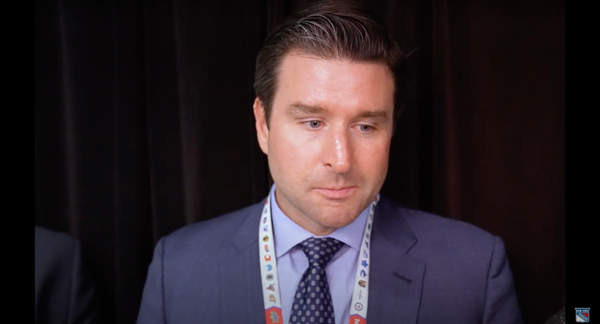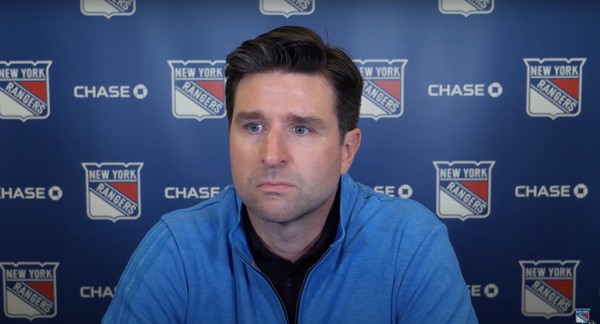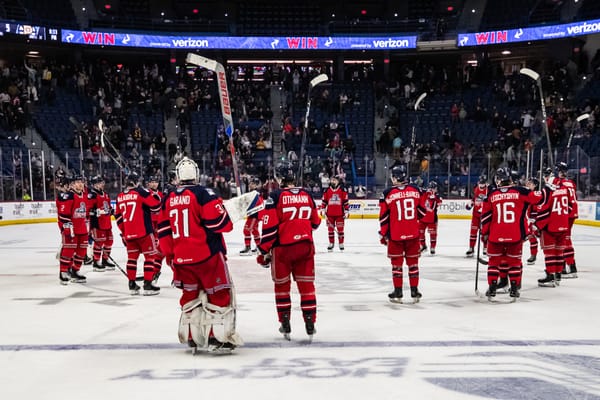It’s Time to Wake up and Address the Homophobia in Hockey
We all need to do more.
On August 14, Anders Nilsson of the Vancouver Canucks told Swedish outlet Aftonbledet that hockey’s homophobic culture is hurting the sport. The NHL has been making an effort to change that culture with events like Hockey is For Everyone Month and its partnership with You Can Play, but change has been slow in coming. Many believe that it simply isn’t happening fast enough.
To date, there has never been an openly gay player in the NHL. The other three major professional sports leagues in North America have all had active and/or retired players who have come out as openly gay. You don’t need to know the statistics to understand that there’s a problem here. We have all seen the headlines about players getting caught using homophobic slurs on and off the ice.
Clearly, hockey is not for everyone.
Many believe that there are and have been gay men in the NHL. The data we have about human sexuality supports that theory. It is statistically improbable that there hasn’t been a gay man in the NHL in the last 100 years. But an improbability is not an impossibility, and there are a lot more factors at play here than just math.
There are a lot of barriers that stand between a young hockey player and their dream to play in the NHL. Skill level and natural athletic ability are probably the first two barriers that come to mind for most of us, but they are just the tip of the iceberg. Many youth hockey players also have to overcome roadblocks because of their family’s income, where they live, their mental and physical health, the color of their skin, their gender identity, and their sexuality.
“That’s why I think when people say there are three to four gay players on each [NHL] team, I say no, absolutely not,” Nilsson explained in his interview with Aftonbledet. “They quit when they were younger. There’s no one who would dare to or want to keep playing. Team sports are about the feeling of togetherness, it’s just as fun to go there to hang out and have someone to talk to as the actual sports, but if you have a hard time in the dressing room when you’re a teen it’s not as fun to play hockey on the field either.”
Nilsson, an outspoken LGBTQ advocate, was the first NHL player to wear a pride flag on his helmet. Knowing everything he knows now, he believes that he would have quit playing hockey in his teens if he was gay. And that is because homophobic slurs are, unfortunately, commonplace on the ice, in the stands, and in locker rooms all over the hockey world.
Dave Bidini hit the nail on the head on this issue two years ago for the Globe and Mail. Here’s an excerpt from his column “Hockey and Homophobia: We are All Complicit.”
But from minor midget to bantam to the junior ranks to college hockey, homophobic and sexist slurs exist because they are allowed to exist. This is partly because some of the people who run the sport – who coach it, parent it, play it – haven’t done a good enough job carrying the game into the 21st century, and partly because the young men who play are emotionally and intellectually arrested, being deprived of education and life guidance in pursuit of a nearly impossible dream.
Brock McGillis, a retired Canadian goaltender who played professionally in the Netherlands, is another hockey player who has spoken out about the sport’s homophobic culture. McGillis, now 34, was once a promising hockey prospect. He played major junior for the Sault Ste. Marie Greyhounds and the Windsor Spitfires, but the homophobia in hockey forced him to live a double life as a young gay man. He partied, drank, dated girls, and did everything he could to conform with his teammates. Eventually, he grew to hate himself, and on more than one occasion, he tried to take his own life.
“It’s our job to create a culture and an environment where a gay player knows he is safe and welcome.” - Gary Bettman
Today, McGillis is a public speaker in Canada. He’s sharing his story in the hopes that it will help chip away at the toxic anti-gay attitudes that are destroying the sport that he loves. Unfortunately, hockey’s culture hasn’t changed much since McGillis was playing in the OHL.
“I heard stories of a junior team last year, on the first day with the team … the coach looked at them and said, ‘I don’t want any f—s on this team,’” he said. “And that’s where that cycle continues to perpetuate itself.”
So, what can we do to stop this cycle and change the culture of hockey for the better? Dr. Cheryl MacDonald, a researcher at the University of Alberta, believes that education is the best path forward. She has been studying homosexuality in hockey since 2012 and is currently researching how to make hockey more inclusive for players who identify as LGBTQ.
For Dr. MacDonald, education makes far more sense than forcing the idea of inclusion on to those who might resist it. She also believes that visibility is an essential ingredient in helping people become more accepting of LGBT culture. So, players who are using their platform as professional athletes to promote a message of inclusion — like Nilsson and Washington Capitals goaltender Braden Holtby — are making a difference. But for every positive example set by a player, there seems to be a negative example.
Forgot to tweet this one earlier. I think Braden Holtby missed DC Pride for the first time in two years because they were partying with the Cup, but he was wearing a Pride hat at the bar #ALLCAPS #StanleyCup pic.twitter.com/u8VdkhdY7Q
— Josh Billinson (@jbillinson) June 10, 2018
It’s all too easy to get frustrated by the homophobia in hockey, especially when it feels like the NHL is not doing enough to create the change it says that it wants to see. Still, there has been some progress.
Several players, including Brad Marchard and James van Riemsdyk, have made a stand in the media by saying a gay teammate would be welcome on their team. Two years ago Gary Bettman made it clear that a gay man would be welcome in the NHL. “We certainly don’t want a player to come out for our sake,” Bettman told the Chicago Tribune in June 2016. “It should be what’s right for him and something that he has to be comfortable with. But I think it’s our job to create a culture and an environment where a gay player knows he is safe and welcome. If and when that happens, believe me, that person will have the full support of the commissioner’s office.”
This summer 21 NHL teams — including the New York Rangers — participated in Pride parades and marches. Last year only 12 NHL teams participated in similar events. So, should we celebrate more teams and players making an effort to be inclusive to the LGBT community, or should we raise questions about the 10 NHL teams that didn’t participate? In my opinion we can, and should, do both.
Dr. MacDonald may very well be right in her belief that the best medicine to combat homophobia in hockey is visibility. But one can’t help but think that we also need a healthy dose of accountability to help combat the disease of homophobia in hockey.
In a 2015 study that researched the experiences of gay, lesbian, and bisexual athletes in sports, 76 percent of the 9,500 athletes believed that youth sport was not safe for LGB people. That’s a damning percentage, and it would look all the more damning if it included trans athletes.
Clearly, we all have a lot of work to do.
The language that we use in the stands, in locker rooms, on social media, and around young people matters. So too does the conduct and character of the coaches and other figures of authority in our youth hockey programs. We don’t need to pretend that we live in an idyllic society to expect that our children will enjoy a safe environment when they participate in athletics. We need only believe in the change we want to see, and take action when we recognize problems when they surface.
And make no mistake, the rampant use of homophobic language in sports is a real problem. All slurs are hate speech. And hate speech has no place in or outside of a sporting venue.
If we want to see the NHL have its first openly gay player within the next decade, we all have to do our part to promote a culture of inclusion in hockey. We have to demand more from teams, owners, and coaches, and expect better from the NHL’s players and fans. That means holding those who use homophobic language — at every level of hockey — accountable for their actions. And it goes without saying that the same must be true for those who use racial slurs and misogynistic language on and off the ice.
Many of us have encountered fans who groan at the idea of an NHL team hosting a Pride Night. They fail to understand how important a transparent message of inclusion is to the LGBT community. However, they should be able to understand that homophobia in hockey is like a moat — it’s a barrier between gay players and their dream of playing in the NHL.
Until we do more to build a bridge to the LGBT community, hockey will suffer. And you don’t need to support gay marriage or be comfortable around rainbow flags to understand that.
“What happens is that we will lose gay players, who might otherwise have been the next Sidney Crosby or Connor McDavid or Wayne Gretzky,” Nilsson explained in his interview with Aftonbledet. “We lose talents. And some families with strong feelings about things might feel that, regardless if their son is straight or gay, he shouldn’t play hockey because they don’t want him in that harsh culture where coaches and players call each other all sorts of things. We lose our pride in hockey.”
Note: Nilsson’s quotes have been translated from Swedish.




